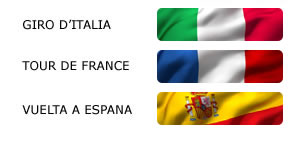

At 227 kilometers, the Potenza-Naples is the longest stage of the 2025 Giro. Departure from Potenza towards Irpinia through the Lucanian mountains with the long climb of Monte Carruozzo Pass (2nd category GPM).
to follow the live coverage of the entire stage starting at 11:30 AM CLICK HERE
In the first part of the day, there are also two flying sprints, located in Muro Lucano after 42 km and in Lioni after 88 km. The second mountain point of the day comes at km 145 and is Monteforte Irpino, a 3rd category climb. After entering the province of Naples, towns follow one another (with the usual traffic obstacles like roundabouts, median strips, pedestrian islands...) while the last 45 km are entirely urban, with a continuous succession of inhabited centers. Before entering Naples, about 20 km are covered on the highway.
The last 3 km have few curves and a slight uphill on cobblestones followed by 2 perfectly flat kilometers until Via Caracciolo. A 900m straight finish line on a 9-meter wide asphalt road, reports Garibaldi.
THE TERRITORY. Potenza, capital of Basilicata, is a city that knows how to surprise. And so do the mountains all around, dotted with charming villages, covered by endless forests or shaped by Aglianico DOCG vineyards, one of the typical Southern wines that have recently become known and appreciated worldwide.
Piazza Mario Pagano, redesigned under the supervision of star architect Gae Aulenti, is the ideal starting point for an itinerary through the Apennine Basilicata, which after crossing Irpinia, reaches Naples. As the riders will do during the sixth stage of the Giro. Before leaving the Lucanian capital, however, one travels along Strada Pretoria, the most lively and engaging street in the city, climbing to the Cathedral of San Gerardo, visiting Palazzo Loffredo which houses the Celestini Chapel, and the National Archaeological Museum of Basilicata Dinu Adamesteanu, offering visitors a general overview of the region's archaeology.
The first stop of the day is in Muro Lucano, the nativity scene-like village literally clinging to the slopes of a limestone rock spur topped by the Cathedral of San Nicola and Camera (12th century) and the imposing Medieval Castle. After crossing the Monte Carruozzo Pass, one enters Campania descending to Conza located next to the artificial lake formed by the Ofanto river waters. It's the right moment for another stop that allows visiting the Archaeological Park of Compsa with the remains of the Roman city where the Roman Forum, Amphitheater, Thermal Baths, Cathedral, and Column-Emblem stand out.
Avellino, the capital of Irpinia, seems jealous of its wonders. And, partly, hides them. Therefore, one must not miss a visit to the treasures of underground Avellino: the Lombard tunnels, Villa Amendola Caves and the hypogeum of Casino del Principe, which tell the secret face of a truly surprising city. And the shop windows displaying leather footwear and clothing should not be surprising: not far from the provincial capital lies the Solofra district of footwear and leather goods, home to dozens of small companies whose products are appreciated on all five continents.
Monteforte Irpino, Nola, Afragola are the stages preceding the always unforgettable entry into Naples. After the race's arrival, one goes to discover (or rediscover) the city. If time is limited, however, objectives must be selected. Which, in no particular order, could be Piazza Plebiscito and Royal Palace, the Cathedral of San Gennaro, Castel dell'Ovo, Maschio Angioino, the Museum and Royal Park of Capodimonte and the Monastery of Santa Chiara. Just to start, though. Because Naples is also the cradle of some absolutely excellent artisan productions, the result of the expertise of its goldsmiths, for example. But it is also home to some of Italy's most exclusive tailoring shops, producers of ties, umbrellas and walking sticks. Noblesse oblige.
